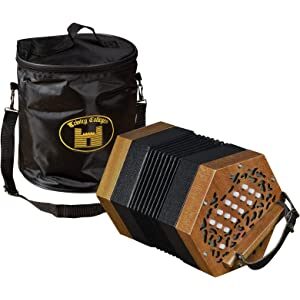The 30-key concertina is the go-to size for traditional Irish music, as its many keys allow more space for experimentation across a range of musical genres and styles.
Concertinas are bellows-driven instruments with expanding and contracting bellows, reed pans, and buttons at either end. Pressing a button causes an action pan to raise up a lever that uncovers a valve; this allows air from the bellows to travel through it into sounding reeds via valve.
Keys
A concertina resembles a squeezebox with two ends that can be pressed together to produce notes. As its design allows it to play different notes depending on whether the bellows are pulled or pushed, each button on a concertina plays different notes depending on its position on its bellows.
Concertinas with 48 keys or buttons typically can cover three octaves from G below middle C to C two octaves above, making a three-octave range.
An Anglo concertina of 30 keys offers three octaves from C below middle C to C two octaves higher, making it ideal for learning Irish music on the concertina.
Layout
The 30 key concertina is an essential instrument for performing traditional Irish music. Most English and Irish players prefer it over any other instrument when engaging in sessions and morris dancing performances etc.
A typical concertina typically features four parallel rows of buttons with support for thumb and little finger placement on either end of the instrument, as well as non-linear buttons near its right hand rest which serve as air release mechanisms.
The concertina features a chromatic scale with two inner rows in particular keys and the outer rows containing diatonic sharps and flats; usually tuned between C/G or lower pitched G/D pitches for optimal playback.
Action
Concertina playing offers various ways of expression. One popular method involves creating “bent” melodies by simultaneously playing multiple notes from within one key.
Concertinas utilize a ‘bisonoric’ system where each button corresponds to two notes; when pushed and pulled respectively. There are multiple keys which can be held in various positions on a concertina; it is essential that players understand which key they’re holding for optimal playback.
An Anglo concertina is widely considered one of the easiest types of concertina to learn on, making it ideal for newcomers to the instrument. Extremely versatile and comfortable to use, its gameplay offers maximum versatility with each note played feeling natural and relaxed.
Reeds
Reeds in a concertina transform the smooth flow of air entering and exiting its bellows into vibrations that require careful manipulation by its player to bring out. Although these vibratory waves may not control what kind of final sound you get, they play an invaluable role in how well a concertina performs.
Reed length and width must be selected so as to balance out the size and volume of an instrument while not overextending or shortening low notes, nor shortening high notes disproportionately. Achieving this requires meticulous planning and skilled craftsmanship as this process can be difficult to do properly.
The window the reed swings through is also crucial for its operation, and should be beveled so as to fit closely at the opening of the shoe but open out as it swings past. This taper may vary depending on its pitch; longer low reeds require less and smaller high reeds often need much more taper.
Maintenance
Concertinas are exquisite mechanical wonders that require meticulous care to function optimally. Their delicate mechanical construction requires regular attention in terms of temperature and humidity changes; for this reason it is vital that they be stored somewhere with an ambient temperature between 18-25C for best results.
Keep the bellows compressed when not in use to prevent them from loosening and losing their elasticity, which may result in air leaking from them and prevent your concertina from playing properly or at all.


